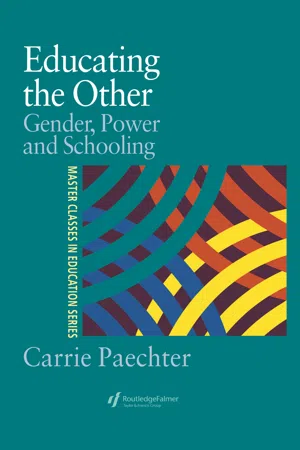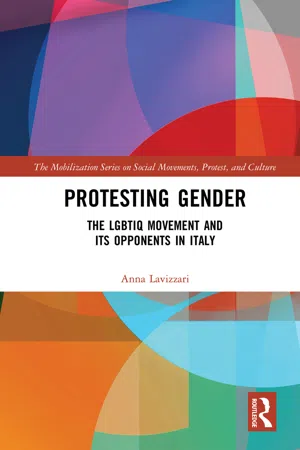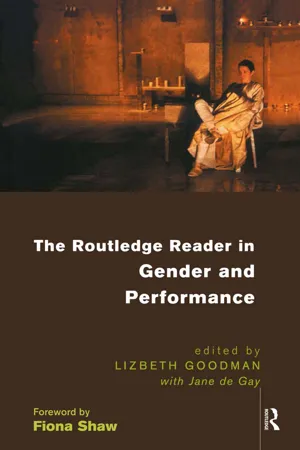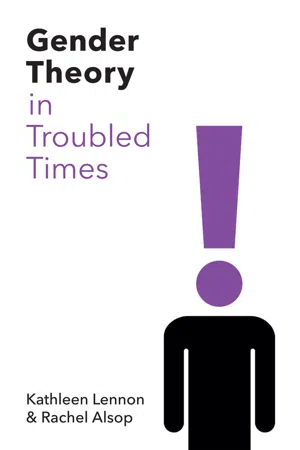Social Sciences
Gender Performance
Gender performance refers to the way individuals express and embody their gender identity through behavior, appearance, and mannerisms. It encompasses the social and cultural expectations associated with gender and how individuals conform to or challenge these norms. Gender performance is a key concept in understanding the complex and multifaceted nature of gender identity and expression.
Written by Perlego with AI-assistance
Related key terms
11 Key excerpts on "Gender Performance"
- eBook - ePub
- Helmi Järviluoma, Pirkko Moisala, Anni Vilkko(Authors)
- 2003(Publication Date)
- SAGE Publications Ltd(Publisher)
One of the most influential feminist theorists of the recent decade, Judith Butler (1990; 1997) sees gender both as a symbolic form of ‘public action’ and an identity deriving from the recurrences of that action. She argues that there is no gender identity prior to the expression of gender, rather, that gender identity is constituted by the repetition of performative expressions (1990: 24–5). Butler belongs to those feminist theorists who theorize the body and its relation to gendered subjectivity, and who reject ‘sex’ as something that is bodily given, to which the construct of gender is added. Butler sees sex ‘as cultural norm which governs the materialization of bodies’ (1993: 2–3). Gender categories, such as ‘man’ and ‘woman’ are representations constructed within cultural institutions. They are thus cultural constructions.Performance and performativity in Butler’s use should not be mistaken as simply some kind of masquerade or an intentional play with gender roles (for instance, choosing to play the role of, to perform, a manly woman). Performativity refers to the performative constitution of gendered conventions. According to Butler (1993: 234), performance as an event (such as a staged performance) has to be separated from performativity, which consists of norms which precede and guide the performance and the performers. Power is always important in Gender Performance. Gender Performance is bounded by the gender system surrounding it, even though it may seem to contest, mask, or oppose conventional gender roles. Therefore, Gender Performance should be understood not only as a negotiation between an individual and his or her cultural surroundings and its conventions, but as repeated performances of the gender system, with their capacity for change and alteration. ‘A performative act is one which brings into being or enacts that which it names, and so marks the constitutive or productive power of discourse’ (ibid.: 134).Gender, like other cultural categories such as ethnicity and sexuality, is performed differently in different situations and locations. Gender Performance, like any performance of other cultural categories, takes place as a negotiation between context-bound and situational subjects. The gender system of the culture (including power relations) and personal experiences are involved in the gender negotiation. The performance of gender is not simply the performance of bodies, human beings in action; the concept of performativity is applicable also to language use and other cultural texts, such as the arts. The usefulness of performativity in gender analysis of many kinds of qualitative materials, such as music and film, conversation, literary and interviewed texts and in fieldwork, will be demonstrated later in this volume. - eBook - ePub
Gender Diversity and Sport
Interdisciplinary Perspectives
- Gemma Witcomb, Elizabeth Peel, Gemma Witcomb, Elizabeth Peel(Authors)
- 2022(Publication Date)
- Routledge(Publisher)
Through cultural socialisation we learn the meanings behind gender and unconsciously reproduce these meanings through committing to normative Gender Performances. In this way, gender is understood here as a ‘doing’, not a ‘being’. It does not refer to a single, coherent or stable identity category, but instead can be understood as performative (Butler, 1999). The understanding of gender as performative is common within academic discussions on the topic, informing the work in a range of disciplines (see, for example, Cameron, 1996 ; Campbell, 2000 ; Plumridge et al., 2002). Judith Butler’s (1999) theorisation of gender performativity in her book Gender Trouble is particularly influential in this respect and introduces the notion that the appearance of a ‘gendered self’ is produced via the ‘regulation of attributes along culturally established lines of coherence’ (Butler, 1999, pp. 32–33). By this she means that gendered behaviours and attributes – those we commonly associate with femininity and masculinity – are imposed upon us by socio-cultural regulations. In this way Butler suggests that gender is socially constructed through speech acts and nonverbal communication. She contends that gender identity is an effect, rather than the cause, of our performances, arguing that ‘there is no gender identity behind expressions of gender…[gender] is performatively constituted by the very “expressions” that are said to be its results’ (1999, p. 33). For Butler, identity is retroactively constructed and comes into being through these expressions. Through bodily gestures, movements, and enactments of various kinds we establish the ‘illusion of an abiding gendered self’ (1988, p. 519), bringing into being categories of male and female, man and women. This performativity of gender is not merely a single act, but ‘a set of repeated acts within a highly rigid regulatory frame that congeal over time to produce the appearance of substance, of a natural sort of being’ (Butler, 1999, p - eBook - ePub
Explicit Utopias
Rewriting the Sexual in Women's Pornography
- Amalia Ziv(Author)
- 2015(Publication Date)
- SUNY Press(Publisher)
FIVESexuality beyond Gender
Gender Performativity in Lesbian PornographyA nother way in which women’s pornography—and lesbian porn in particular—tackles the problem of female sexual subjectivity is by offering a performative understanding of gender. In other words, if sexual subjectivity is incompatible with femininity as it is constructed, one way around this impasse is to demonstrate that women are not bound to femininity and can “do” masculinity just as well. Such an understanding of gender in effect reformulates, perhaps even sidesteps, the question of female sexual subjectivity, since by disrupting the fictitious coherence of sex and gender it severs the link between female embodiment and any particular form of gendered subjectivity.Before moving on to examine the ways in which pornographic texts construct gender as performative, I will first discuss the notion of performance itself in its multiple contemporary theoretical usages, focusing on the most elaborate and sophisticated theoretical formulation linking gender and performance, Judith Butler’s theory of gender performativity.What Is Performance?
The term “performance” figures as a central concept in an array of contemporary discourses across several disciplines, from performance art and theater studies, to anthropology, sociology, psychology, linguistics, and literary criticism.1 The signification of the term differs from field to field, as well as from thinker to thinker, but the various concepts are also interrelated, often derived from one another. Broadly speaking, the concepts of performance developed by the social sciences are figuratively derived from the notion of theatrical performance, in other words, the term “performance” serves to highlight those features of social action—such as role playing or the scriptedness of social interactions—that it shares with the theater.2 Alternatively, such concepts convey the recognition of a continuum between the theater and other social behaviors like rituals, ceremonies, play, and other forms of public behavior.3 - eBook - ePub
Judith Butler
Sexual Politics, Social Change and the Power of the Performative
- Gill Jagger(Author)
- 2008(Publication Date)
- Routledge(Publisher)
Gender Trouble and the ways in which gender can usefully be thought of in terms of performances and acts, and how this relates to the body.‘In what senses, then, is gender an act?’
5Gender, then, is an act in the sense that ‘doing’ gender involves ‘sustained social performances’ which involve the repetition of socially established meanings. It is also an act in the sense that ‘gender attributes and acts [are] the various ways in which a body shows or produces its cultural signification’ (Butler 1990a: 141). In so doing, such acts effectively constitute the identity they would seem to merely express, or reveal.In other words, gender acts are what constitute embodied beings as gendered subjects in keeping with the norms of compulsory heterosexuality. They involve an on-going process of continual repetition (‘sustained social performances’) through which individual subjects do (act out) their gender, in a ‘stylized repetition of acts’. This ‘stylized repetition of acts’ involves bodily movements and gestures (corporeal styles) that are socially approved and politically regulated in keeping with ‘a cultural field of gender hierarchy and compulsory heterosexuality’ (p. 139). The enactment of gender is thus socially approved and politically regulated rather than dictated by some kind of internal nature.Indeed, far from being an internal property of a pre-existing subject, a stable identity or source of agency as in a metaphysics of substance, gender is rather tenuously constituted in time through this ‘stylized repetition of acts’. It is through this that the illusion of a stable fixed identity is promoted, perpetuated and believed. Butler is using the notion of ‘style’ in the combined sense of Sartre’s ‘a style of being’, Foucault’s ‘stylistics of existence’, and de Beauvoir’s view of bodies as ‘styles of the flesh’ to get at the way in which gender is a kind of ‘corporeal enactment’. Furthermore, she emphasizes that ‘these styles are never fully self-styled, for styles have a history and those histories condition and limit the possibilities’ (p. 139). Therefore, although the body plays a vital role in all this, it is not as in the naturalistic fallacy; that the gendered body is performative ‘suggests it has no ontological status apart from the various acts which constitute its reality’ (p. 136). It is rather in the Foucauldian sense of a ‘surface politics of the body’ in Gender Trouble. Hence, gender becomes ‘an enacted fantasy or incorporation’ in which acts, gestures and desires produce the effect of an internal core or substance, but produce this on the surface of the body. ‘Such acts, gestures, enactments, generally construed, are performative in the sense that the essence or identity that they otherwise purport to express are fabrications - eBook - ePub
Performing Ethnicity, Performing Gender
Transcultural Perspectives
- Bettina Hofmann, Monika Mueller(Authors)
- 2016(Publication Date)
- Routledge(Publisher)
Gender, according to Butler, is “a construction that conceals its genesis, the tacit collective agreement to perform, produce and sustain discrete and polar genders as cultural fictions is obscured by the credibility of such productions” (Gender Trouble 140). Nevertheless, in a statement that seems to allow for a certain measure of deliberateness, she contends that a resignification of a dominant norm can actually provide a glimpse of a “more enabling future”: “[A resignification] is an appropriation that seeks to make over the terms of domination, a making over … which repeats in order to remake—and sometimes succeeds” (137). Theorists have argued about the scope of such a resignification, and, along with those inspired by her work, Butler herself has been criticized for forging “an argument for the performative as politically relevant agency” (Rothenberg 72). 4 While the extent of contingency in performativity remains debatable, Butler undoubtedly opened up ways of showing that categories like sex and race, that once seemed fixed because of physical markers, are actually discursively constructed and consolidated by their repeated performances. Cultural theorists like to engage with the idea that, like gender/sex, ethnicity/race can be performed and modified through performance. In working with Butler’s insights they usually take one of two basic approaches: a “cosmopolitan” approach that calls attention to the fact that modern subjects have arrived at a stage where they can try out and “consume” aspects of ethnicity or a political stance that wants to instrumentalize the performance of ethnicity to actively change negative scripts associated with aspects of ethnicity. Both approaches stress individual and collective agency and deemphasize the idea that identity-forming processes are so complex that they withstand redirection - eBook - ePub
Educating the Other
Gender, Power and Schooling
- Dr Carrie Paechter, Carrie Paechter(Authors)
- 2002(Publication Date)
- Routledge(Publisher)
The inscription of masculinity and femininity on the body in this way emphasizes the performative nature of gender roles. In seeing gender as performative I am explicitly regarding it as something that is achieved, worked on (Kessler and McKenna, 1978; McNay, 1992), something that is not natural but which provides an illusion of naturalness which is seen as justifying power differentials (Weir, 1994). Kessler and McKenna (1978) note that what transsexuals have to do consciously is no more than what we all do, but unconsciously: everyone is engaged in ‘passing’, displaying for others the gender we wish to have attributed to us. Butler (1990) writes that:That the gendered body is performative suggests that it has no ontological status apart from the various acts which constitute its reality…acts and gestures, articulated and enacted desires create the illusion of an interior and organizing gender core. (p. 136)The political and discursive origin of gender identity, she argues, is displaced onto the illusory psychological ‘core’. What this implies is that in order to preserve our sense of gender identity, we as individuals have to perpetuate and regulate our performance of the gender roles seen as ‘appropriate’ by society. Furthermore, she suggests, the masculine subject’s power and autonomy depends on feminine reflection of it. Similarly, Davies (1989) argues that our current understandings of what it is to be a person require individuals to take themselves up as distinctively male or female. The opposition embedded in these terms is one in which part of the definition of one is dominance over the other. This means that males have much more invested in the policing of the masculine/feminine boundary than do females and the requirement to ‘perform’ gender therefore becomes very important for males (Mac an Ghaill, 1996). As femaleness may be ascribed in the absence of male cues, to be recognized as male, one has to ensure that one continues to exhibit the marks of maleness, masculine behaviour. Masculine behaviour is thus more narrowly circumscribed than is feminine. As a result, more boys than girls are perceived as ‘gender disordered’ and there are more sanctions, both legal and social, on male than on female homosexuality (Bern, 1993).Compulsory Heterosexuality
Boldt (1996) points out that ‘normal’ femininity and masculinity have neither intelligibility nor power without the contrasting presence of ‘abnormality’. In Western society, normality and abnormality are particularly strongly constructed around sexuality and sexual orientation; desire is constituted in heterosexual terms (Butler, 1990). Connell (1987) notes that what constitutes an object of desire is organized by the dichotomy and opposition of feminine and masculine; each is expected to desire the other, and part of the Othering of women is bound up with masculine desire. Young (1994) points out that, as part of the construction of gender, the assumptions and practices of heterosexuality themselves define the meaning of bodies; for example, women’s bodies are used as objects of exchange between men (Rich, 1980; Young, 1994). Furthermore, sexual practice is organized around heterosexual couple relationships in which sexual difference is seen as providing erotic flavour (Connell, 1987). All of this has a number of effects on the construction of masculine and feminine roles and, as a result, gender identities (Holloway, 1984). - eBook - ePub
Gender Communication Theories and Analyses
From Silence to Performance
- Charlotte Kroløkke, Anne Scott Sorensen(Authors)
- 2005(Publication Date)
- SAGE Publications, Inc(Publisher)
6 Gender and PerformanceC onsidering gender in terms of performance has radically changed the agenda of gender and communication. The “performance turn” not only denotes a new intellectual framework, it alters communication policies by attending to situated performances. Since this book is intended to sharpen analytic skills, we shall focus on how the performance turn in feminist communication scholarship is generated from a new poststructuralist basis. In this chapter, we start by presenting significant studies from the performance and positioning perspectives, move on to examine research in a media and organization context, and conclude with a case and a sample analysis illustrating the methodology of feminist poststructuralist discourse analysis.Gender, Performance, and CommunicationKristin M. Langellier is one of the researchers who has explored the possibilities of adding performativity to feminist communication studies (Langellier 1989, 1999; Langellier, Carter, & Hantzis, 1993; Langellier & Peterson, 2004). She has been inspired by the work of Judith Butler (1990) but has also researched the field of classic performance studies, linking the embodied practice of performance art to the recent performance turn. She has also elaborated on the distinction between performance and performativity: Whereas performance designates a type of imperfection that implies a transgressive desire for agency and action, performativity articulates a display of differences that challenges the forces of discourses and institutionalized networks of power (Langellier, 1999, p. 129). This distinction clarifies the differences between some of the attempts to effectuate the performance turn. In light of Butler’s and Langellier’s work, we consider this turn to be a long struggle, perhaps not yet fully affected. Thus, we have come to think of it in terms of two phases: an early phase, to be described in this chapter, and a later phase, to be tentatively outlined in Chapter 7 - eBook - ePub
Protesting Gender
The LGBTIQ Movement and its Opponents in Italy
- Anna Lavizzari(Author)
- 2019(Publication Date)
- Routledge(Publisher)
the mimetic acquisition of a norm is at once the condition by which a certain resistance to the norm is also produced; identification will not ‘work’ to the extent that the norm is not fully incorporated or, indeed, incorporable. The resistance to the norm will be the effect of an incomplete acquisition of the norm, the resistance to mastering the practices by which that incorporation proceeds.(Butler 1999: 118)Identifying does not mean being identical. While we incorporate a norm, it remains something not entirely comparable, and it is this discrepancy which nestles the germ of resistance to the norm. Performativity is also multiple: it is an instrument of domination and a strategy of resistance, the way in which we can exist as something different. Performativity’s symbolic violence has been to make only thinkable those categories in which we are equal to ourselves. The mandatory identity which we were forced to look for, desire and pursue, is the work which the symbol is committed to reiterate. To show the ineffectiveness of the norm, its flaw, can become the occasion and the method to re-articulate it and subvert it. It is in the gap of the rule, in that which cannot be fully absorbed, unfulfilled, that lays the turning point. It is not a question of distancing from a system of rules, however, it is a matter of making it sway from the inside (2011 [1993]: 169–185).As I mentioned before, Gender Performances can therefore be perceived as particularly contentious and transgressive acts, especially when they challenge other people’s expectations about how women and men should behave. How, then, can we account for gender as a social performance? For the purpose of this research, gender will be considered as being acted out in the form of sustained social performances, through bodily gestures, styles and discursive means, and as symbols that are socially approved and expected based on a cultural notion of mandatory heterosexuality. In the process of performing gender, individuals produce and signify their own identity.The chapter critically synthesizes the conceptual and theoretical analysis of gendered aspects during protests. Indeed, the idea of habitus as a practical sense for acting which is embodied by agents, rather than as a set of conscious dispositions (Haluza-DeLay 2008), helps us find a hinge between structure and agency. Moreover, habitus must be considered conservative and long-lasting in its nature, and thus somehow resistant to change. This might be particularly enlightening when exploring gender, since society is generally intransigent to change in gender practices and norms. Transposing this idea to the field of social movements allows us to understand that parallel to mainstream society, comprised of people who resist change and subscribe to doxa - eBook - ePub
- Lizbeth Goodman, Jane de Gay, Lizbeth Goodman, Jane de Gay(Authors)
- 2002(Publication Date)
- Routledge(Publisher)
Or perhaps I should say, fields of specialization, for ‘gender’ and ‘performance’ are distinct fields which overlap but which also diverge and lead off in any number of unexpected directions. Academic work has, similarly, overlapped with practical work in the theatre and in the media as ideas about both gender and performance have developed. The terms ‘gender’ and ‘performance’ are defined in the articles included. Definitions vary and criss-cross, sometimes contradict each other but more often lead on from and clarify points from one author’s work to another’s. This rich field benefits from multiple perspectives, from analysis from different positions and comparative thought across disciplines, jobs, reasons for reading and studying about women and the theatre. This Reader does not attempt to cover any subject or period in the wide fields of ‘gender and performance’ in depth, but instead offers brief introductions to most of the main ideas, areas of work and schools of thought in common currency. The many contributions intersect as authors refer to and occasionally argue with each other. While most of the selections are quite recent or were specially commissioned for this book, a few were written years ago and may now seem a bit dated by the standards of the coming millennium and its demand for topicality. It would not suffice, though, to provide only the most challenging and exciting new pieces by leading critics, as these would not make sense without the necessary foundations. Instead, this book includes short extracts from the essays and books which have been shown to be most often read, studied, cited and discussed in classrooms and seminar groups. These ‘classic’ texts are discussed by the authors who introduce each chapter, and are compared and contrasted with more recent theoretical pieces by critics and scholars whose work engages with both theory and practice in a more ‘topical’ way - eBook - ePub
- Jeffrey C. Alexander(Author)
- 2013(Publication Date)
- Polity(Publisher)
Attacking the hegemonic exercise of sexual rather than class power, Butler (1999) makes a similar argument. The successful performance of gender, she claims, makes invisible the patriarchal power behind it. The difference is that, by drawing upon the theories of Austin and Turner, Butler (1999) can explicitly employ the language of performance. “Gender is … a construction that regularly conceals its genesis; the tacit collective agreement to perform, produce, and sustain discrete and polar genders as cultural fictions is obscured by the credibility of those productions … The appearance of substance is precisely that, a constructed identity, a performative accomplishment which the mundane social audience, including the actors themselves, come to believe and to perform in the mode of belief” (1999: 179).When post-ritual drama emerged in ancient Greece, Aristotle (1987) explained that a play is “an imitation of action, not the action itself.” When re-fusion occurs, this cautionary note goes unheeded. The performance achieves verisimilitude – the appearance of reality. It seems to be action, not its imitation. This achievement of the appearance of reality via skillful performance and flow is what Barthes (1972a [1957]) described in his celebrated essay on “true wrestling.” He insisted that the “public spontaneously attunes itself to the spectacular nature of the contest, like the audience at a suburban cinema … The public is completely uninterested in knowing whether the context is rigged or not, and rightly so; it abandons itself to the primary virtue of the spectacle, which is to abolish all motives and all consequences: what matters is not what it thinks but what it sees” (1972a [1957]: 15).How does cultural pragmatics work? The inner structures of social performanceHaving elaborated the criteria of performative failure and success, I now turn to a more detailed discussion of the elements and relations that sustain it. I will draw upon the insights of drama theory to decompose the basic elements of performance into their more complex component parts, and I will link these insights to the social dramas that compose the public sphere. To be able to move back and forth between theatrical and social drama enriches both sides of the argument; it also helps document my core empirical claim. Social action in complex societies so often is ritual-like because it remains performative. The social conditions that gave rise to theater also gave rise to post-ritual forms of symbolic action. - eBook - ePub
- Kathleen Lennon, Rachel Alsop(Authors)
- 2020(Publication Date)
- Polity(Publisher)
2The notion of performance invokes the actor on the stage.3 This might suggest a distinction between an identity that is, in some sense, a pretence and everyday identities that are real. But for Butler there is no such distinction; performance gives as much reality as selves contain. She points out that, if we accept that becoming gendered is a social process that is not dictated by bodily shape, then there is nothing to guarantee that the body of the one who becomes woman will necessarily be what is normally conceived of as a female body. The discussion of drag performance then becomes pivotal to her account. Drag is viewed as a parodic or exaggerated form of gender enactment, by means of which originary or authentic gender identity is exposed as itself an effect of performance. In a drag performance the apparently natural packaging of biology and gender is pulled apart. The audience, aware that it is watching a body with a certain anatomy, watches as a gendered identity is produced that is, according to regulatory gender norms, at variance with it. Then, Butler suggests, we recognize that everyday gender is just such a performance.In Bodies that Matter (1993), Butler discusses Jenny Livingston’s film Paris is Burning (1990), a documentary about drag balls in New York City attended by primarily Latino and some African-American participants in the trans community:The balls are contests in which the contestants compete under a variety of categories. The categories include a variety of social norms, many of which are established in white culture as signs of class, like that of the ‘executive’ and the Ivy League student; some of which are marked as feminine, ranging from high drag to butch queen; and some of them, like that of the ‘bangie’, are taken from straight black masculine street culture. [In each category the winner is the person who is most real in their class.] … realness is the ability to compel belief, to produce the naturalized effect. This effect is itself the result of an embodiment of norms, an impersonation of a racial and class norm … [an] ideal that remains the standard which regulates the performance, but which no performance fully approximates. (1993: 129)
Index pages curate the most relevant extracts from our library of academic textbooks. They’ve been created using an in-house natural language model (NLM), each adding context and meaning to key research topics.










